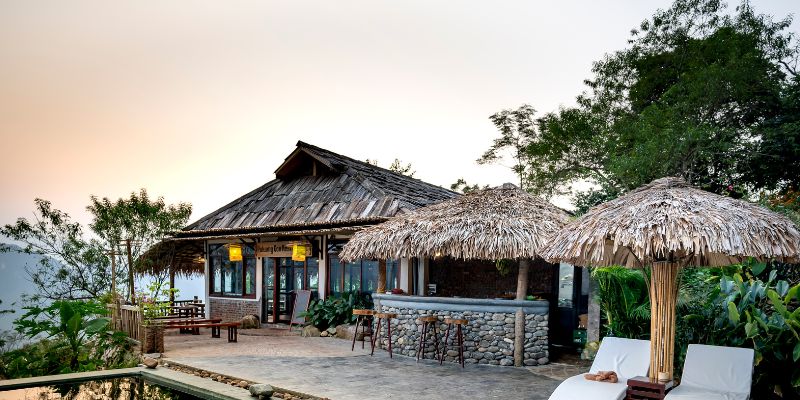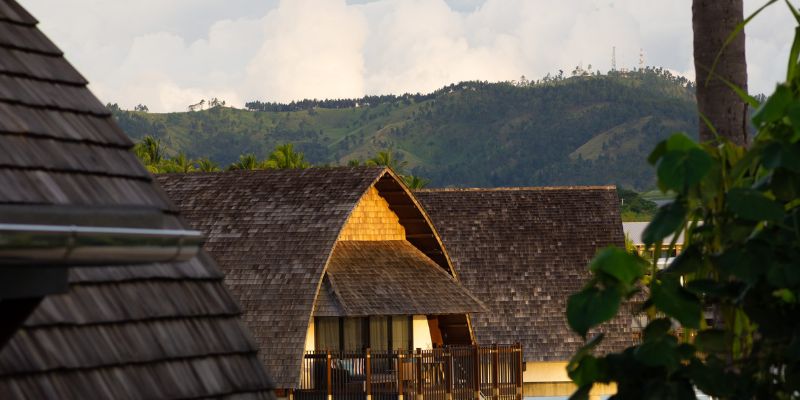On the Cauvery River in the Mandya district of Karnataka is the little settlement of Bheemeshwari, located between the Shivanasamudra and Mekedatu waterfalls. The mahseer fish of the Cauvery River find their native habitat in Bheemeshwari, making it a fantastic ecotourism destination. The quality of Mahseer has made it one of the most sought-after game fish in the world.
Elephants, crocodiles, leopards, wild boars, and monkeys, not to mention herons, ibises, cormorants, and kingfishers, all make their homes in the dense vegetation around the village. Bheemeshwari has become an important fishing center because of the river Cauvery. Each year, hordes of hopeful fishermen go here hoping to reel in a catch.
There are now several fishing camps in this area, as the Mahseer is considered India's premier game fish. Tents at these campgrounds come with all the essentials, including beds, mosquito netting, a toilet, and a shower. The open-air dining area is the primary location for communal meals.

Bheemeshwari Adventure and Nature Camp
The Cauvery River is everything from placid. Its path has breathtaking scenery, from gorges to waterfalls, rapids, and lush woods. The Bheemeshwari Adventure and Nature Camp was built to honor this mighty waterway. This camp is close enough to civilization for convenience yet far enough away to feel like a world apart from the monotony of regular life.
Bheemeshwari Adventure and Nature Camp is the perfect spot for anybody looking for a thrilling experience or a peaceful retreat into nature. Some exciting options are kayaking, Zip lining, rope walking, and other extreme sports.
Elephants, deer, crocodiles, turtles, snakes, and almost 200 kinds of birds are some of the wildlife that may be seen here. However, the largest known tropical gamefish, the Mahseer, is the main attraction. This elusive monster still greatly influences this area, even though it is now impossible to trap one here.
When To Visit
After the monsoons, the river thrives between August and February, and the forest is lush and verdant, making it an ideal vacation destination. It is also prime time for bird viewing, as several species of water birds, such as woodpeckers, river terns, kingfishers, fishing eagles, and others, congregate in this area. During the dry months, large sandbars are exposed, making for pleasant nighttime strolls. Extreme heat is possible during the afternoons of the summer months (March–June).

Places To Visit In Bheemeshwari
Shimshapura Falls
The Shimsha River is a small waterway that flows into the larger Cauvery. At Shimshapura, in the Mandya district, the river drops precipitously in a waterfall. Other smaller rivers accompany the waterway downstream, including the Kanihalla Hebbahalla Mullahalla, Chikkahole Kanva, and Veeravaishnavi.
The Shimshapura Falls can be found in the Shimsha village of the Malavalli Taluk and 106 kilometers from Bheemeshwari Adventure and Nature Camp. In addition to the waterfall, the Shimsha Hydroelectric Project may also be found there.
Galibore Fishing Camp
Bheemeshwari is 121 kilometers from the Galibore Fishing Camp, located in the dense forests of the Cauvery Wildlife Sanctuary, and is reached by the Kanakapura-Sangam Road. The camp was named after the windy hilltop, Galibore, that sits just across from it and serves as a welcome respite from the camp's urban surroundings.
Many different things might keep you busy here. One must partake in the coracle rides. In addition to going on jungle treks, campers can relax in hammocks outside their shelters, surrounded by the lush green canopy of the forest and the soothing sounds of the nearby river. Since the weather is mild and great for birdwatchers between September and February, that is when you should plan your trip.
Cauvery Fishing Camp
The Cauvery Fishing Camp, also known as the Bheemeshwari Nature And Fishing Camp, is a popular destination. Kayaking, zip-lining, Rope-walking, and other sports are available at the camp, all of which use the camp's stunning location on the banks of the river Cauvery.
Only 64 kilometers distant along the Kanakapura road, the Cauvery Fishing Camp is conveniently located near Bheemeshwari. The tents in this camp resemble a caravan parked on the riverbank.
More than 200 different kinds of birds have made the camp their home. This Bheemeshwari camp is at its finest between September and February when the weather is mild, and the birds are out in full force.
Shivanasamudra Falls
The breathtaking Shivanasamudra Falls is 140 kilometers from Bheemeshwari Adventure and Nature Camp. One of the top tourist destinations in Bheemeswari and Karnataka is known as "Shiva's Sea" in its native Sanskrit.
The peak season for seeing this spectacular cascade is from August through October. The Shivanasamudra Falls, where the Kaveri River drops 90 meters, comprises two separate waterfalls: Gangachukki and Bharachukki.
From a height of almost 320 feet, the two massive parallel streams of Gaganachukki plunge down the granite bed of the waterfall in a horsetail form. Bharachukki, a cascading waterfall, drops 70 meters and splits into several streams as it winds through the expansive granite outcrops. You can get there in about a kilometer from Gaganachukki.
The Best Way to Get Around Bheemeshwari.
Some people may find it easier than others to settle into the role of conscientious traveler. As a conscientious traveler, you should constantly try to lessen the damage you cause to the planet. Renting a bicycle is a fun and efficient way to go about Bheemeshwari's neighborhoods. You can assist the environment while cutting costs and boosting your health.
One of the best parts of traveling is gaining exposure to new cultures. Always remember how essential it is to respect the local culture wherever you find yourself. The dress standards at many establishments are strict, so make sure you know what to expect before you go.
Conclusion:
Among the best Bheemeshwari resorts in Karnataka is the Bheemeshwari Adventure and Nature Camp. It is nestled among the area's rolling hills and verdant woods on the banks of the Cauvery River. Tents and cottages are available for visitors, and they may also choose from a wide selection of activities and facilities at the camp.
Adventure sports enthusiasts will love the Cauvery River for its thrilling rapids and breathtaking landscape. Campers may learn about the local flora and wildlife by participating in nature walks and birding activities.

Pushkar Tourist Attractions

Nature Walk To Tea Gardens In Darjeeling

Dubai Travel Guide: All you need to know

Top Spots for Remarkable Hot Air Balloon Viewing in Cappadocia

Lothal, Gujarat: How to Reach, Best Time and Tips

Luxury Stay at Nibaana Dharamshala Resort: Unveiling Accommodation Options

Everything You Need To Know About Melbourne's St. Patrick's Cathedral

River Rafting In Tattapani, Shimla

Best Places To Celebrate New Year 2023 In Mumbai: An Overview

Know About Wild West Motorcycle Adventure: California To Texas

Best Paris Travel Guide
